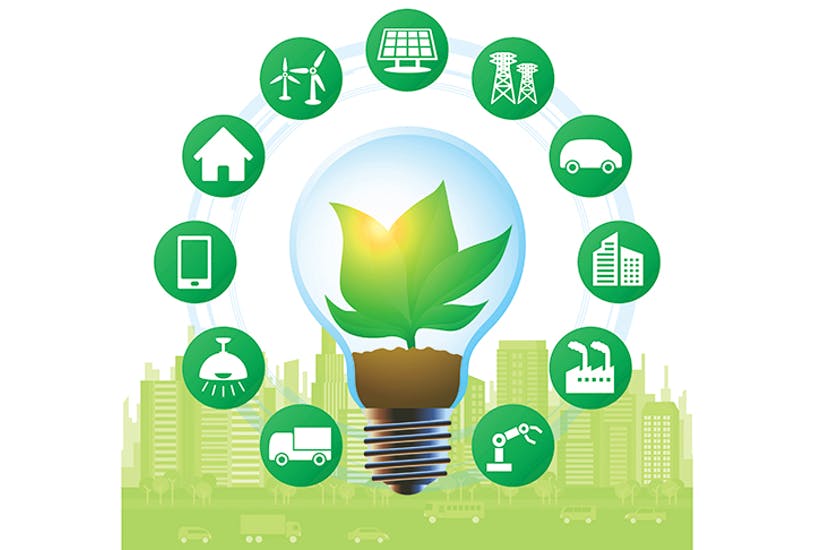In 1698, the English engineer Thomas Savery patented a coal-fuelled steam engine, and in doing so lit the long fuse of the industrial revolution. Over the next 200 years, coal became the dominant source of power in Britain, outstripping wind, water and labour. In 1882, the world’s first coal-fired electric power plant was opened — and Britain has been emitting greenhouse gases ever since. Is it time we got smarter?
In the past 150 years, in becoming wiser to its environmental drawbacks, we’ve slowly fallen out of love with coal. In order to reduce our carbon emissions, the UK has focused on generating more of its energy from renewable sources. But these too have their challenges. Many are weather-dependent — meaning they need to be supported by fossil fuels during periods of intermittent supply.
The solution to the problem is smarter energy infrastructure: a digitised system, enabled by the mass rollout of smart meters in households an d small businesses, which would help manage energy supply and demand more efficiently. The system, which uses near real-time data feedback, makes it easier to incorporate renewables into our network. For the first time, we will have near real-time visibility of our household energy consumption.
By gathering near real-time data on energy use, the smart energy system can build a much more accurate picture of supply and demand. This can help energy networks to distribute our electricity in a much more efficient way, better integrating renewables such as wind and solar into our energy system. For example, greater battery capacity means strong intermittent renewable power can be retained within the system, to be used in periods of high demand (thus reducing the need for wind and solar power to be supported by fossil fuels or nuclear). Simultaneously, dynamic tariffs would encourage users to make better use of power (for example, to charge electric cars) when renewable supply is at its highest.
By using these incentives the smart energy system can lower peak demand and reduce the overall cost of supplying energy, while also helping households save money. Beyond human demand management, there is also the potential for smart homes to help further reduce our carbon footprint. Smart appliances reading live price data are able to change their behaviour to account for it — avoiding using energy at expensive, high-demand times, but in a way that doesn’t affect the household. A smart freezer, for example, could adjust its temperature very slightly in response, as might a heating system, while a smart washing machine might automate its timing to take advantage of periods when renewable energy is at its cheapest.
The smart energy system will also enable homes to act as storage units for renewable energies, and, via peer-to-peer trading, exchange any excess energy back into the system itself. Households with solar panels or extra battery storage could potentially earn money by selling their energy to their local community. The government’s policy paper on smart meters talks about how this will open up new innovative energy markets, while the National Grid’s future energy scenarios report envisions a future where large electricity companies cease to dominate and ‘there is a transition to more distributed supply patterns’.
One area where this is particularly relevant is electric cars. Electric vehicles need to be charged and spend most of their time — particularly at night — parked. Could they also help with the supply of energy during periods of high demand? Nissan chief executive Karl Anders has spoken about the ‘enormous potential’ of vehicle-to-grid energy exchange, stating that if their entire fleet of electric cars were connected to the grid they would have the capacity to put 180MW of energy back into it — the equivalent of two power plants.
In the National Grid’s future energy scenarios, smart charging electric vehicles — which flip between taking and supplying energy, based on prices — could become part of the energy mix. They could both supply individual homes and contribute to wider storage, with each home becoming the owner of its own small power plant.
This could be just the start of an energy sector shake-up, as the next wave of green entrepreneurs takes advantage of the opportunities presented by smart meters and the smart energy system more generally. The energy consultancy Delta-EE predicts that smart meters will trigger a wave of innovation in the energy market where providers develop new services based on demand profiles. Analysts are already predicting that, before long, households will in effect purchase energy outcomes (e.g. a warm house) and it will be up to suppliers to deliver the exact kWh of electricity and gas in the greenest and most efficient way possible — including matching items of large demand (like the charging of an electric car) with the lowest cost sources of renewable energy.
The data from smart meters also helps us to understand much more about how we’re using energy — and to identify which decarbonisation efforts are most effective in the fight against climate change. Delta-EE predicts that the data will provide for a more rigorous analysis of technologies intended to reduce carbon emissions (such as renewable heating technologies) by measuring their outcomes against real data rather than benchmark assumptions.
If we develop decentralised energy markets, links between smart devices, and apps for their management domestically, Britain can benefit from more efficient and reliable low-carbon energy, while also ensuring our energy system is better equipped for the 21st century.
It’s a big change to how we think about our energy infrastructure, but it’s one that’s already under way.







Comments